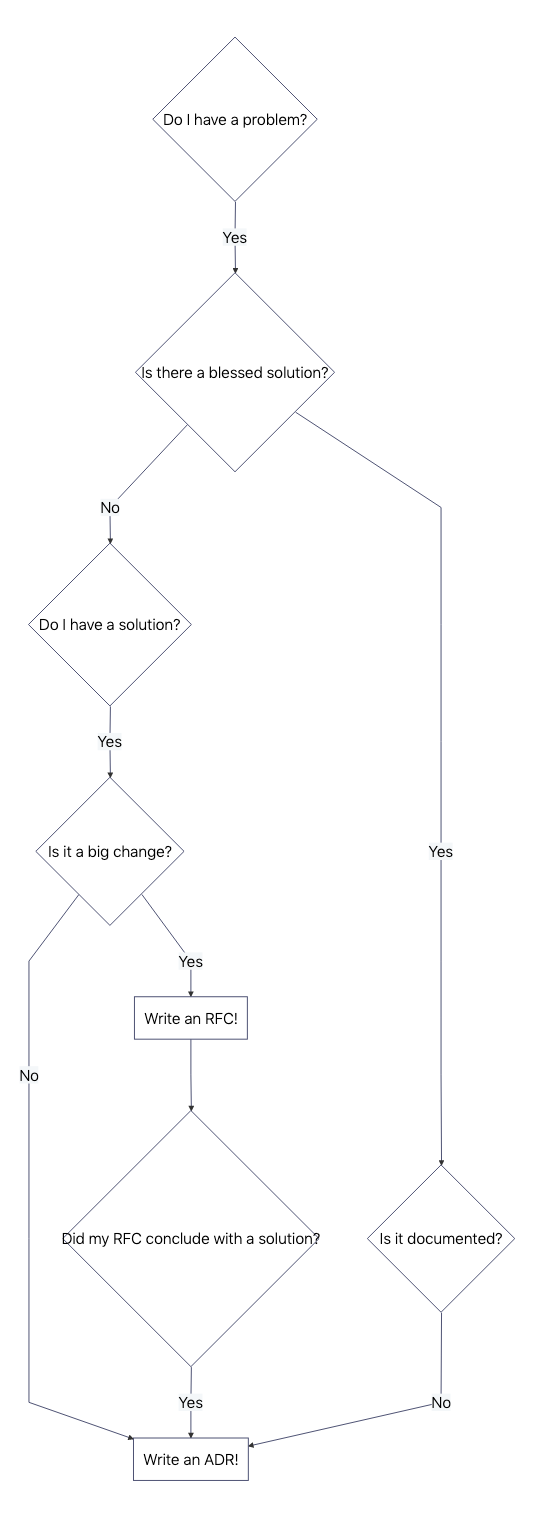This content originally appeared on Level Up Coding - Medium and was authored by Lucas Fernandes
Decision-making is at the core of any successful software project. Whether you’re selecting the right technology stack, defining architectural patterns, or evaluating trade-offs, every decision has a profound impact on the outcome of your project. However, as projects evolve and team members come and go, it’s easy to lose track of why certain decisions were made in the first place. This is where Architecture Decision Records (ADRs) shine as an invaluable tool.

The Importance of Decision-Making in Software Projects
Every software project starts with a set of choices:
- Architecture: Should you adopt a monolith, microservices, or serverless architecture?
- Technology Stack: Which frameworks, programming languages, and databases best suit your needs?
- Trade-offs: Do you prioritize speed of development, performance, or scalability?
These decisions are often influenced by the context of the project at the time — deadlines, team expertise, client requirements, or budget constraints. While these factors provide clarity in the moment, they can fade over time, leaving future developers wondering: Why did we choose this approach?
Challenges Without Documentation
Without a clear record of decisions, teams may face several challenges:
- Knowledge Loss: As team members leave, the rationale behind key decisions often goes with them.
- Rework: Developers might unknowingly revisit past debates, wasting time and effort.
- Technical Debt: Without understanding the original context, teams might make changes that introduce inconsistencies or inefficiencies.
- Onboarding: New team members struggle to get up to speed without understanding the project’s foundational decisions.
What Are Architecture Decision Records (ADRs)?
An ADR is a lightweight, structured document that captures an architectural decision made for a project, along with its context and consequences. Each ADR typically includes the following:
- Title: A concise name for the decision (e.g., “Use PostgreSQL for the Database”).
- Context: The background information, including the problem to solve and constraints.
- Decision: The choice made and a brief description.
- Consequences: The implications, trade-offs, and potential risks of the decision.
- Status: Whether the decision is proposed, accepted, or deprecated.
ADRs can be stored as Markdown files in your repository, ensuring they are versioned alongside your code.
When should I write an ADR ?
This workflow development by Spotfty help us to understand the ADR process creation:

How to Start Using ADRs in Your Project
- Introduce the Practice: Start by educating your team on the value of ADRs.
- Define a Template: Use a standard format for consistency. Here’s an example:
- Start Small: Begin with new decisions and gradually document existing ones.
- Review Regularly: Revisit ADRs periodically to ensure they’re still relevant.
- Integrate with Your Workflow: Store ADRs in your project’s repository and reference them during planning and code reviews.
Template Example
# Title
## Context
- Describe the problem to solve.
- Highlight constraints and influencing factors.
## Decision
- State the chosen solution.
## Consequences
- Detail the trade-offs and potential impacts.
## Status
- Indicate whether the decision is active or deprecated.
Real-World Example
Imagine your team needs to choose a database for a new microservices application. After evaluating options, you decide on PostgreSQL due to its strong ACID compliance, scalability, and robust ecosystem. An ADR would look like this:
# Use PostgreSQL for the Database
## Context
We need a relational database to support our microservices application. Key requirements include strong ACID compliance, scalability, and support for complex queries.
## Decision
We chose PostgreSQL due to its proven performance, active community, and compatibility with our existing tools.
## Consequences
- Positive: Ensures data integrity and supports complex queries.
- Negative: Requires more setup and management compared to NoSQL options.
## Status
Accepted
Benefits of Using ADRs
- Preserves Context: ADRs ensure that every decision is well-documented and the context is preserved for future reference
- Facilitates Collaboration: By creating a shared understanding, ADRs help teams discuss and evaluate options more effectively
- Improves Onboarding: New developers can quickly understand the project’s architectural history and reasoning
- Supports Change Management: When revisiting decisions, teams can evaluate them against their original rationale to determine if circumstances have truly changed
- Reduces Technical Debt: Teams can avoid ad-hoc changes that don’t align with the original architecture
Companies That Use ADRs
Many leading organizations have adopted ADRs as part of their software development practices to maintain clarity and consistency in their projects. Some examples include:
- Spotify: Uses ADRs to facilitate cross-team collaboration and knowledge sharing. (https://engineering.atspotify.com/2020/04/when-should-i-write-an-architecture-decision-record/)
- Amazon: Utilizes ADRs to document architectural decisions for their complex and large-scale systems. (https://docs.aws.amazon.com/pt_br/prescriptive-guidance/latest/architectural-decision-records/architectural-decision-records.pdf)
- Google: Employs ADR-like practices to ensure continuity across global teams. (https://cloud.google.com/architecture/architecture-decision-records?utm_source=chatgpt.com&hl=pt-br)
These companies demonstrate how ADRs can scale effectively, even in the most demanding and dynamic environments.
Conclusion
ADRs are more than just documentation — they’re a powerful way to manage your project’s architecture and ensure continuity over time. By adopting ADRs, you empower your team to make informed decisions, preserve critical knowledge, and maintain alignment as your project evolves. Start using ADRs today and set your project up for long-term success.
Feel free to leave comments or suggestions, and share with other developers who might benefit from this solution!
Follow me for more exciting content
How Architecture Decision Records (ADRs) Can Help Manage Software Architecture was originally published in Level Up Coding on Medium, where people are continuing the conversation by highlighting and responding to this story.
This content originally appeared on Level Up Coding - Medium and was authored by Lucas Fernandes
Lucas Fernandes | Sciencx (2025-01-07T18:35:16+00:00) How Architecture Decision Records (ADRs) Can Help Manage Software Architecture. Retrieved from https://www.scien.cx/2025/01/07/how-architecture-decision-records-adrs-can-help-manage-software-architecture/
Please log in to upload a file.
There are no updates yet.
Click the Upload button above to add an update.
